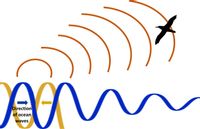信天翁在觅食时以次声为导向
作者:Lesley H.Thorne
期刊:PNAS
许多大型海洋脊椎动物表现出令人印象深刻的运动能力,它们在觅食或迁徙过程中行进数千公里,并且通过定向旅行反复返回特定地点。这些物种在幼年时离开出生地,经常穿越旅行于海洋盆地,并在数年后返回同一地点进行繁殖。在进行这些大范围的移动时,远洋海洋脊椎动物必须克服在高度动态且相对无特征的(缺乏固定视觉地标的)环境中导航的艰巨挑战。有效的导航对于它们的经济性移动至关重要,这不仅在长时间移动或迁徙过程中不可或缺,而且在日常活动中也是如此。它使动物能够有效地移动,以便觅食、躲避捕食者和寻找配偶。鸟类在动物导航研究中一直扮演着核心角色,但对于信天翁等远洋海鸟的导航能力的详细了解却一直难以实现。Gillies等人(2023)利用标记信天翁的数据为远洋海鸟的潜在导航线索提供了新的见解。
(实习生刘熙茜编译)

Fig. 1 Microbaroms, a form of infrasound produced by the collision of large ocean waves of similar frequendes traveling in opposite directions, can be detected over large distances (thousands of kilometers). Gillies et al suggest that microbaroms could provide a mechanism through which seabirds can detect stormy regions associated with large waves. The authors show that tagged wandering albatrosses orient toward regions of high microbarom sound pressure levels.
Many large marine vertebrates show impressive movement abilities, traveling thousands of kilometers during foraging trips or migrations and returning repeatedly to a specific site using directional travel (1). These species leave their natal site as juveniles, often traveling across ocean basins and returning years later to the same site to breed (2). In undertaking these extensive movements, pelagic marine vertebrates must overcome the formidable challenge of navigating in a highly dynamic and comparatively featureless environment, without fixed visual landmarks. Effective navigation is paramount to economical movement, not just during extended movements or migrations but also day-to-day, and allows animals to move efficiently in order to forage, avoid predators, and search for mates (3, 4). Birds have played a central role in research examining animal navigation (5), but a detailed understanding of the navigational abilities of pelagic seabirds such as albatrosses has remained elusive. Gillies et al. (2023) use data from tagged albatrosses to provide new insight into potential navigational cues for pelagic seabirds (6).
Read more
Lesley H. Thorne, Albatrosses orient toward infrasound while foraging, Proceedings of the National Academy of Sciences (2023). DOI: 10.1073/pnas.2314980120








